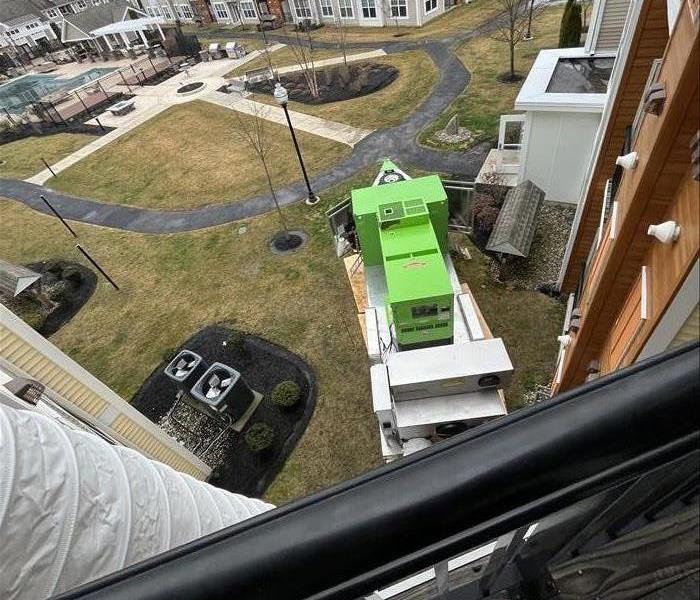Mold in Drywall: Identification and Repair Tips from SERVPRO®
9/16/2024 (Permalink)
 This guide will walk you through how to detect mold in drywall and provide expert tips for proper remediation.
This guide will walk you through how to detect mold in drywall and provide expert tips for proper remediation.
Mold is a common issue that can compromise the structural integrity of your home in Providence, RI, especially when it infiltrates drywall. For homeowners and business owners alike, identifying and addressing mold in drywall early can save you time, money, and stress. This guide will walk you through how to detect mold in drywall, provide expert tips for proper remediation, and offer insights into why professional intervention is often the best choice.
How to Identify Mold in Drywall
Knowing how to spot mold in drywall is critical. Mold typically grows in areas with high moisture or humidity, such as basements, bathrooms, or kitchens. Unfortunately, drywall's porous nature makes it an ideal surface for mold spores to settle and grow, often unnoticed. Here are some signs that you might have mold growing within your drywall:
- Discoloration: Mold can appear as dark or greenish stains on the surface of the drywall. Often mistaken for dirt or shadows, these spots may gradually increase in size over time.
- Musty Odor: A persistent musty smell can be an indicator of hidden mold within the drywall.
- Bulging or Warping: As mold thrives on moisture, the drywall may begin to warp, bubble, or bulge.
- Visible Mold Growth: In advanced cases, mold might appear as fuzzy or slimy patches on the surface of the drywall.
- Water Damage: Areas of drywall that have suffered water damage are prime spots for mold growth. If the drywall has experienced flooding, leaking, or high humidity, mold could soon follow.
These signs may not always be obvious, which is why early detection and intervention are key to preventing extensive damage.
Common Causes of Mold in Drywall
Understanding what causes mold in drywall can help you prevent it from spreading further. Some of the most common reasons mold appears in drywall include:
- Leaking Pipes: Leaks behind walls or ceilings can go unnoticed for long periods, leading to moisture buildup that fosters mold.
- Roof Leaks: A leaking roof can drip into walls, creating prime conditions for mold to grow in drywall.
- Humidity and Poor Ventilation: High humidity levels, especially in areas like bathrooms or basements, can allow mold to thrive.
- Flooding or Water Damage: Flooded drywall or rooms with frequent water damage often develop mold if not dried quickly.
According to the Environmental Protection Agency (EPA), the presence of moisture for 24-48 hours can be enough for mold to begin growing on surfaces like drywall. Learn more about mold growth from the EPA.
Expert Tips for Repairing Mold-Damaged Drywall
Once you’ve identified mold in your drywall, it’s essential to handle the situation swiftly and correctly. The process of repairing mold-damaged drywall involves the following steps:
- Stop the Source of Moisture: Whether it’s a leaking pipe, roof, or poor ventilation, stop the source of moisture before you begin any mold remediation. Otherwise, mold will continue to grow.
- Remove Affected Drywall: Cut out and discard any moldy sections of drywall. It's often best to remove at least 12-18 inches beyond the visible mold to ensure all contaminated material is gone.
- Disinfect the Area: Once the moldy drywall is removed, clean and disinfect the underlying surfaces. Use an antimicrobial cleaner specifically designed for mold.
- Install New Drywall: After removing mold-damaged sections and disinfecting the area, install new drywall. Make sure it is properly sealed to prevent future moisture infiltration.
- Ensure Proper Ventilation: After replacing the drywall, ensure the area is well-ventilated. Installing proper ventilation or dehumidifiers in high-humidity areas can help prevent mold from returning.
While minor cases of mold in drywall can sometimes be handled by the homeowner, larger infestations often require professional intervention. Mold can easily spread to other areas, making it difficult to manage without the right equipment and expertise.
Why Choose SERVPRO® for Mold Remediation?
Mold remediation requires specialized knowledge and equipment to ensure that the problem is fully eradicated. SERVPRO offers professional mold removal and drywall repair services, making sure the job is done right the first time.
SERVPRO’s team of certified technicians uses advanced techniques to safely remove mold from your drywall and restore your property to its pre-damage condition. With industry-leading equipment and a commitment to excellent service, SERVPRO is a trusted partner for homeowners and business owners dealing with mold problems.
Preventing Future Mold Growth in Drywall
After mold remediation, prevention is key to avoiding a recurrence. Here are a few proactive steps you can take:
- Fix Leaks Immediately: Address any plumbing or roofing issues as soon as they arise.
- Use Dehumidifiers: Keep humidity levels below 60% in your home, especially in basements or bathrooms.
- Ventilate: Make sure high-moisture areas are well-ventilated, especially after showers or baths.
- Regular Inspections: Regularly inspect your home for signs of water damage or leaks, especially in humid areas.
Conclusion
Mold in drywall is a common but serious issue that requires timely identification and professional remediation. Whether it’s water damage, humidity, or hidden leaks, understanding the causes and symptoms of mold can help you address the problem quickly. For expert drywall mold removal, SERVPRO provides reliable, effective solutions, ensuring your home or business stays mold-free.
Preventing mold growth through regular inspections and proper moisture control is the best way to keep your drywall in good condition for years to come. Trust SERVPRO for expert mold identification, repair, and prevention strategies.






 24/7 Emergency Service
24/7 Emergency Service